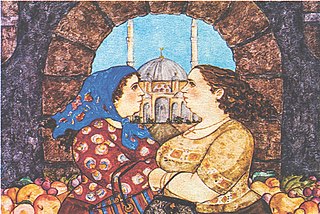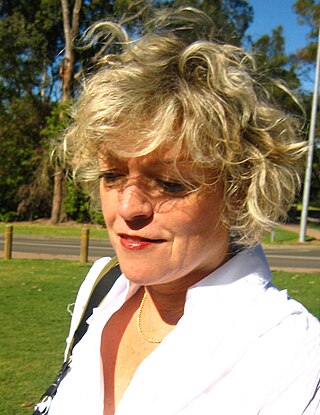Marjetica Potrč is an artist and architect based in Ljubljana, Slovenia. Potrč's interdisciplinary practice includes on-site projects, research, architectural case studies, and drawings. Her work documents and interprets contemporary architectural practices and the ways people live together. She is especially interested in social architecture and how communities and governments can work together to make stronger, more resilient cities. In later projects, she has also focused on the relationship between human society and nature, and advocated for the rights of nature.
Anne-Mie Van Kerckhoven is a Belgian artist whose work involves painting, drawing, computer art and video art.

Angela Bulloch, is a Canadian artist who often works with sound and installation; she is recognised as one of the Young British Artists. Bulloch lives and works in Berlin.
Tomma Abts is a German-born visual artist known for her abstract oil paintings. Abts won the Turner Prize in 2006. She currently lives and works in London, England.
Kirstine Roepstorff is a Danish visual artist who moves between collage and sculpture, as well as producing books. She resides and works in Fredericia, Denmark. In 2016, she represented Denmark in the Danish Pavilion at the 57th International Art Exhibition. In 2018, her works were showcased in the comprehensive solo exhibition "Renaissance of the Night" at Kunsthal Charlottenborg in the Royal Danish Academy of Art.
Julie Ault is an American artist, curator, and editor who was a cofounder of Group Material, a New York-based artists' collaborative that has produced over fifty exhibitions and public projects exploring relationships between politics and aesthetics. She was awarded a MacArthur Fellows Program grant, commonly referred to as a MacArthur Genius Grant, in 2018 in recognition for her achievements "redefining the role of the artwork and the artist by melding artistic, curatorial, archival, editorial, and activist practices into a new form of cultural production."

Iñaki Bonillas is an artist living and working in Mexico City. His recent work is based on the photographic archive of his grandfather J.R. Plaza and family. In 2007 he participated in a group exhibition at Claremont Museum of Art.
Trisha Donnelly is a contemporary artist who is particularly well known as a conceptual artist. Donnelly works with various media including photography, drawing, audio, video, sculpture and performance. Donnelly is also a Clinical Associate Professor of Studio Art at New York University. She currently lives and works in San Francisco, California. Trisha Donnelly is represented by Galerie Buchholz, Matthew Marks Gallery, and Galerie Eva Presenhuber.

Pedro Cabrita Reis is one of the foremost visual artists of his generation and also one of Portugal’s most internationally renowned artists. His work features a wide variety of media – painting, sculpture, photography and drawing – and has been exhibited and included in numerous national and international museum collections. He lives and works in Lisbon.
Alan Uglow (1941–2011) was a British visual artist, who moved from London to New York City in 1969. Called "a painter's painter" by Roberta Smith, in addition to his paintings, Uglow made objects, sound-and-visual installations, photographs and prints. He died 20 January 2011, in Manhattan, at age sixty-nine, from complications related to lung cancer.
Moyra Davey is an artist who has been living in New York City since 1988. She works across photography, video, and writing. Davey is known for her experimental films that take root in written monologues, her portraits, and her essays that pair photography and language.

Francisco Tropa is a Portuguese sculptor and visual artist. He lives and works in Lisbon.
Monica Bonvicini is a German-Italian artist who works with installation, sculpture, video, photography and drawing mediums to explore the relationships between architecture and space, power, gender and sexuality. She is considered part of a generation of artists that expanded on the critical practices of the 1960s and 1970s to conceive of space and architecture as a material that could engage with discourses of power and politics, defining art as an active form of ‘critique’. She was awarded the Golden Lion at the Venice Biennale in 1999 and the Preis der Nationalgalerie from the Staatliche Museen zu Berlin in 2005. She was appointed Commander of the Order of Merit of the Italian Republic in 2012.
John Zurier is an American abstract painter, known for his minimal, near-monochrome paintings. His work has shown across the United States as well as in Europe and Japan. He has worked in Reykjavik, Iceland and Berkeley, California. Zurier lives in Berkeley, California.
Chicago Project Room (CPR) was a contemporary art gallery founded in 1996 by Michael Hall in Chicago.

Gülsün Karamustafa is a visual artist and filmmaker recognised as "one of Turkey’s most outspoken and celebrated artists." Using personal and historical narratives, Karamustafa explores socio-political issues in modern Turkey and addresses themes including sexuality-gender, exile-ethnicity, and displacement-migration. "Hailed as one of Turkey’s most influential contemporary artists," her work reflects on the traumatic effects of nation building, as it responds to the processes of modernization, political turbulence, and civil rights in a period that includes the military coups of 1960, 1971, and 1980. Karamustafa was one of the laureates of the 2014 Prince Claus Award, a prestigious award presented to "individuals for their outstanding achievements in the field of culture and development and the positive effect of their work on their direct environment and the wider cultural or social field." She lives and works in Istanbul.

Ingrid Bachmann is a Canadian contemporary artist based in Montreal known mostly for her interactive kinetic sculptures that mix technology and ordinary everyday objects. Her work has been exhibited throughout Canada, and internationally in the United States, Peru, Brazil, Germany, Belgium, Scotland, Australia and Cuba. Exhibitions include the 11th Havana Biennial (Cuba), the Quebec Biennial, Manifestation d’art International 6 (Canada), Flesh of the World (Canada), Command Z: Artists Exploring Phenomena and Technology (USA), and Lab 30 (Germany).
Julia Fish is an American artist whose paintings have a deceptive simplicity. She paints in oil on stretched rectangular canvases of varying size. By means of close observation of everyday subjects—leaves of a tree seen through a window, a section of floor tiles, an old fashioned light fixture— she makes, as one critic says, "quiet, abstract manifestations of observed realities." She is a studio artist who paints not what she sees in an instant but rather what she observes continuously, day after day. The result, she says, is not so much temporal as durational. Her paintings compress many instances of observation so as to become, as she sees it, "a parallel system to a lived experience." The paintings lack spatial orientation and, as a critic says, can "be described as both highly realistic and abstract without compromising either term." In 2008, Alan G. Artner, writing in the Chicago Tribune, said "This is work of small refinements and adjustments. The world of everyday things generates it, but Fish's qualities of seeing and touch elevate the things to a plane on which they leave behind their humble character."

Carla Arocha and Stéphane Schraenen, also shortened to Arocha & Schraenen, are an artist duo that collaborates since 2006. Arocha & Schraenen work across media, producing paintings, drawings and prints. Large-scale mirrored and interactive sculptural installations are at the core of their collaborative project. Their abstract installations and sculptures stem from everyday objects. The artists strip such objects from functionality, thus reducing them to their basic essence and form. Engaging with the rich tradition of geometrical abstract and optical art, the artists’ works are often placed in a spatial context where light and reflection play a crucial role.
Silke Otto-Knapp (1970–2022) was a German artist. Her work was shown at numerous galleries and shows including the Bienal de São Paulo. the Istanbul Biennial and the Liverpool Biennial. She is represented by Galerie Buchholz, Cologne/Berlin/New York and greengrassi, London.







